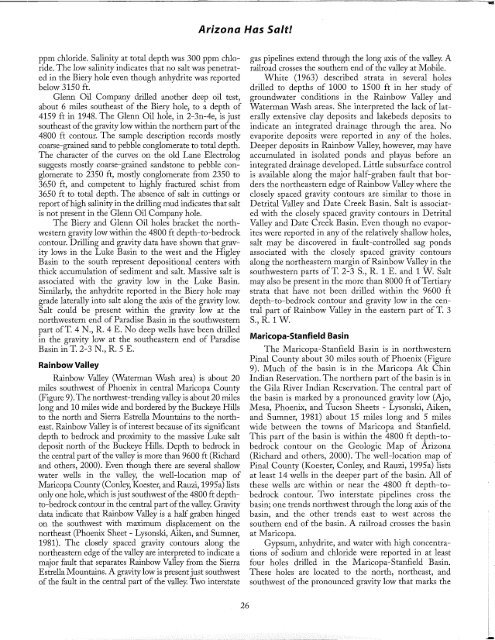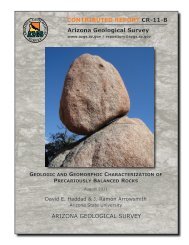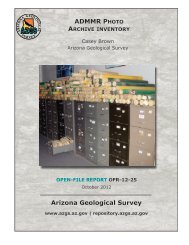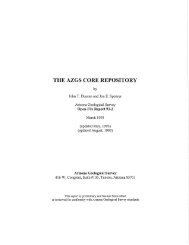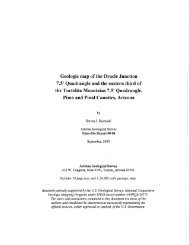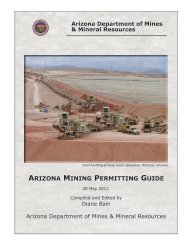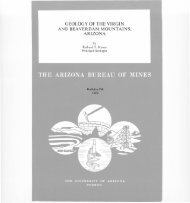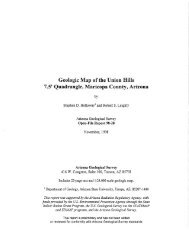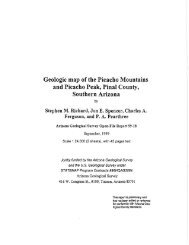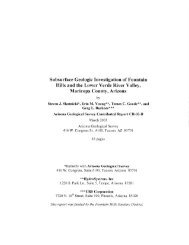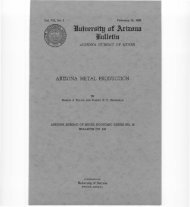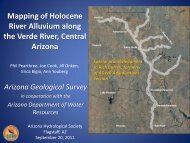Arizona has Salt! - 41 p. - AZGS Document Repository
Arizona has Salt! - 41 p. - AZGS Document Repository
Arizona has Salt! - 41 p. - AZGS Document Repository
Create successful ePaper yourself
Turn your PDF publications into a flip-book with our unique Google optimized e-Paper software.
ppm chloride. Salinity at total depth was 300 ppm chloride.<br />
The low salinity indicates that no salt was penetrated<br />
in the Biery hole even though anhydrite was reported<br />
below 3150 ft.<br />
Glenn Oil Company drilled another deep oil test,<br />
about 6 miles southeast of the Biery hole, to a depth of<br />
<strong>41</strong>59 ft in 1948. The Glenn Oil hole, in 2-3n-4e, is just<br />
southeast ofthe gravity low within the northern part ofthe<br />
4800 ft contour. The sample description records mosdy<br />
coarse-grained sand to pebble conglomerate to total depth.<br />
The character of the curves on the old Lane Electrolog<br />
suggests mosdy coarse-grained sandstone to pebble conglomerate<br />
to 2350 ft, mosdy conglomerate from 2350 to<br />
3650 ft, and competent to highly fractured schist from<br />
3650 ft to total depth. The absence of salt in cuttings or<br />
report ofhigh salinity in the drilling mud indicates that salt<br />
is not present in the Glenn Oil Company hole.<br />
The Biery and Glenn Oil holes bracket the northwestern<br />
gravity low within the 4800 ft depth-to-bedrock<br />
contour. Drilling and gravity data have shown that gravity<br />
lows in the Luke Basin to the west and the Higley<br />
Basin to the south represent depositional centers with<br />
thick accumulation of sediment and salt. Massive salt is<br />
associated with the gravity low in the Luke Basin.<br />
Similarly, the anhydrite reported in the Biery hole may<br />
grade laterally into salt along the axis of the gravity low.<br />
<strong>Salt</strong> could be present within the gravity low at the<br />
northwestern end of Paradise Basin in the southwestern<br />
part ofT. 4 N., R. 4 E. No deep wells have been drilled<br />
in the gravity low at the southeastern end of Paradise<br />
Basin in T. 2-3 N., R. 5 E.<br />
Rainbow Valley<br />
Rainbow Valley (Waterman Wash area) is about 20<br />
miles southwest of Phoenix in central Maricopa County<br />
(Figure 9). The northwest-trending valley is about 20 miles<br />
long and 10 miles wide and bordered by the Buckeye Hills<br />
to the north and Sierra Estrella Mountains to the northeast.<br />
Rainbow Valley is ofinterest because ofits significant<br />
depth to bedrock and proximity to the massive Luke salt<br />
deposit north of the Buckeye Hills. Depth to bedrock in<br />
the central part ofthe valley is more than 9600 ft (Richard<br />
and others, 2000). Even though there are several shallow<br />
water wells in the valley, the well-location map of<br />
Maricopa County (Conley, Koester, and Rauzi, 1995a) lists<br />
only one hole, which is just southwest ofthe 4800 ft depthto-bedrock<br />
contour in the central part ofthe valley. Gravity<br />
data indicate that Rainbow Valley is a half graben hinged<br />
on the southwest with maximum displacement on the<br />
northeast (Phoenix Sheet - Lysonski, Aiken, and Sumner,<br />
1981). The closely spaced gravity contours along the<br />
northeastern edge ofthe valley are interpreted to indicate a<br />
major fault that separates Rainbow Valley from the Sierra<br />
Estrella Mountains. A gravity low is present just southwest<br />
ofthe fault in the central part ofthe valley. Two interstate<br />
<strong>Arizona</strong> Has <strong>Salt</strong>!<br />
26<br />
gas pipelines extend through the long axis of the valley. A<br />
railroad crosses the southern end ofthe valley at Mobile.<br />
White (1963) described strata in several holes<br />
drilled to depths of 1000 to 1500 ft in her study of<br />
groundwater conditions in the Rainbow Valley and<br />
Waterman Wash areas. She interpreted the lack of laterally<br />
extensive clay deposits and lakebeds deposits to<br />
indicate an integrated drainage through the area. No<br />
evaporite deposits were reported in any of the holes.<br />
Deeper deposits in Rainbow Valley, however, may have<br />
accumulated in isolated ponds and playas before an<br />
integrated drainage developed. Little subsurface control<br />
is available along the major half-graben fault that borders<br />
the northeastern edge ofRainbow Valley where the<br />
closely spaced gravity contours are similar to those in<br />
Detrital Valley and Date Creek Basin. <strong>Salt</strong> is associated<br />
with the closely spaced gravity contours in Detrital<br />
Valley and Date Creek Basin. Even though no evaporites<br />
were reported in any ofthe relatively shallow holes,<br />
salt may be discovered in fault-controlled sag ponds<br />
associated with the closely spaced gravity contours<br />
along the northeastern margin ofRainbow Valley in the<br />
southwestern parts ofT. 2-3 S., R. 1 E. and 1 W. <strong>Salt</strong><br />
may also be present in the more than 8000 ft ofTertiary<br />
strata that have not been drilled within the 9600 ft<br />
depth-to-bedrock contour and gravity low in the central<br />
part of Rainbow Valley in the eastern part ofT. 3<br />
S., R.l W.<br />
Maricopa-Stanfield Basin<br />
The Maricopa-Stanfield Basin is in northwestern<br />
Pinal County about 30 miles south of Phoenix (Figure<br />
9). Much of the basin is in the Maricopa Ak Chin<br />
Indian Reservation. The northern part ofthe basin is in<br />
the Gila River Indian Reservation. The central part of<br />
the basin is marked by a pronounced gravity low (Ajo,<br />
Mesa, Phoenix, and Tucson Sheets - Lysonski, Aiken,<br />
and Sumner, 1981) about 15 miles long and 5 miles<br />
wide between the towns of Maricopa and Stanfield.<br />
This part of the basin is within the 4800 ft depth-tobedrock<br />
contour on the Geologic Map of <strong>Arizona</strong><br />
(Richard and others, 2000). The well-location map of<br />
Pinal County (Koester, Conley, and Rauzi, 1995a) lists<br />
at least 14 wells in the deeper part of the basin. All of<br />
these wells are within or near the 4800 ft depth-tobedrock<br />
contour. Two interstate pipelines cross the<br />
basin; one trends northwest through the long axis ofthe<br />
basin, and the other trends east to west across the<br />
southern end of the basin. A railroad crosses the basin<br />
at Maricopa.<br />
Gypsum, anhydrite, and water with high concentrations<br />
of sodium and chloride were reported in at least<br />
four holes drilled in the Maricopa-Stanfield Basin.<br />
These holes are located to the north, northeast, and<br />
southwest ofthe pronounced gravity low that marks the


